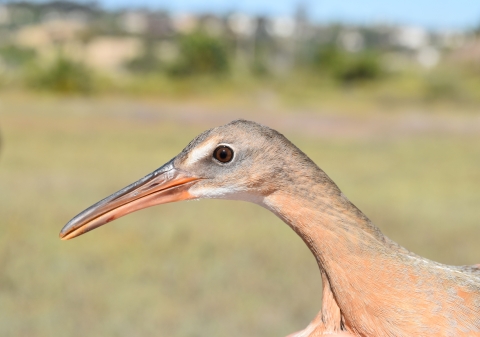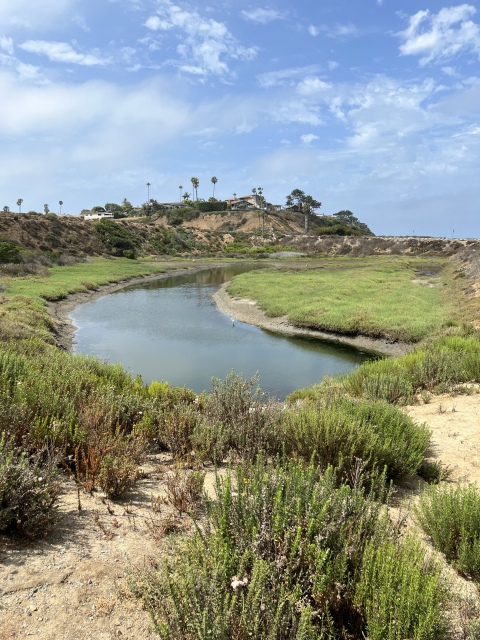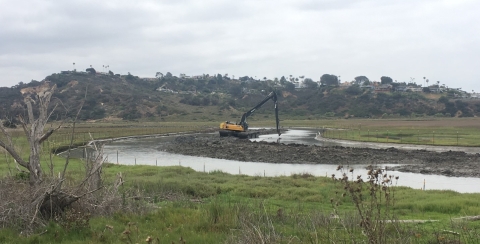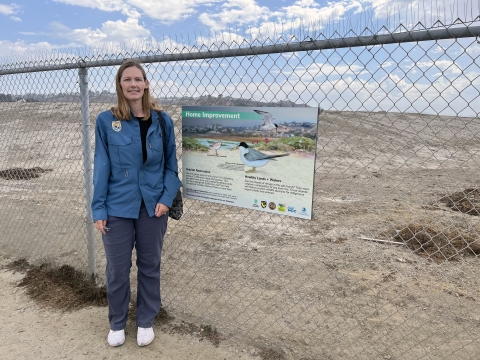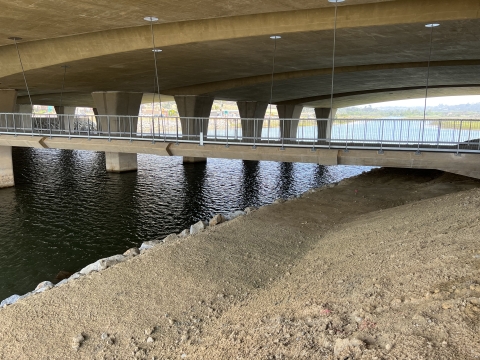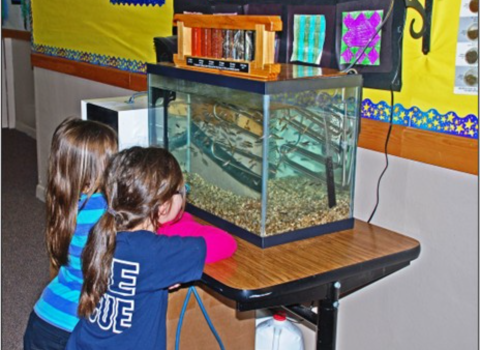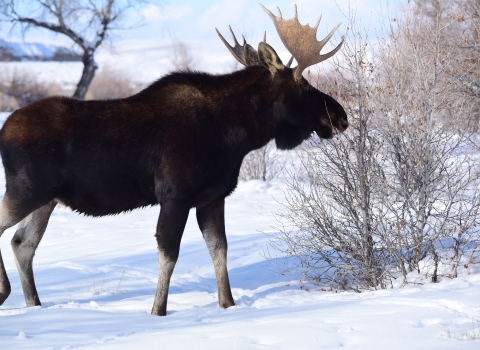San Diego County has more than 70 miles of coastline, home to hundreds of thousands of people as well as many wildlife species. The highly urban area is also congested, and conservation planning can be complicated.
Through the vision, expertise and dedication of multiple agencies, a recently completed segment of the North Coast Corridor (NCC) Program that included restoration of San Elijo Lagoon will improve traffic flow, additional public recreation opportunities, and breathing room for wildlife.
San Diego County’s NCC Program is a set of multi-year projects to increase capacity for Interstate-5 (I-5), railways, and bike and pedestrian trails between the cities of La Jolla and Oceanside. This infrastructure project spans five lagoons: Buena Vista, Agua Hedionda, Batiquitos, San Elijo and San Dieguito, and passes just east of a sixth, Los Peñasquitos.
The Carlsbad Fish and Wildlife Office collaborated with the California Department of Transportation (Caltrans), other federal and state agencies, and conservation organizations to incorporate design and build elements to improve San Elijo lagoon’s ecological health, protect species’ habitat, and slow shoreline erosion between Solana Beach and Encinitas.
“These partnerships enabled us to minimize impacts to sensitive species and habitats, preserve wildlife connectivity, and restore ecosystem processes, while allowing for a broad range of transportation options in the region,” said Carlsbad Office biologist Sally Brown.
Lagoons and surrounding upland habitats provide connectivity for wildlife movement from inland to the coastal region, and support habitat for numerous federally listed species, including the coastal California gnatcatcher, least Bell’s vireo, southwestern willow flycatcher, light-footed Ridgway’s rail, tidewater goby, Del Mar manzanita, California least tern, and western snowy plover.
At the San Elijo Lagoon, constrained tidal and freshwater flows trapped brackish water in the lagoon, and degraded habitats for these sensitive species.
“San Diego coastal habitats are unique in that we have these huge wetlands that are important carbon sinks and provide habitat for a diversity of wetland birds,” said Brown. “The land rises and falls between the wetlands and coastal mesas, providing a broad variety of habitats where rare species are found.”
To incorporate habitat restoration, the transportation project included enhancing tidal channels and lengthening the I-5 bridge span to optimize tidal flows from the ocean into the wetlands, facilitating inland migration of rare coastal salt marsh salt marsh
Salt marshes are found in tidal areas near the coast, where freshwater mixes with saltwater.
Learn more about salt marsh habitats. This will enhance tidal flows, improve water quality, and increase fish and benthic invertebrate diversity.
The planning agencies modeled hydrology for the lagoons, ensuring environmental concerns were considered, and that planned transportation infrastructure would enhance and promote ecological function of the lagoons without constraining future restoration opportunities. The San Elijo Lagoon project began in 2017 and was completed in June 2022.
“The project benefits Ridgway's rails by allowing coastal salt marsh habitats to migrate inland,” said Brown. “The hope is that as tidally influenced low-marsh habitat expands into the east basin it will provide a refuge for rails because the low lying coastal wetlands they live in are threatened by sea level rise.”
To widen the channel, engineers dredged hundreds of thousands of cubic yards of sand and sediment from the lagoon. Instead of the traditional method of flooding the lagoon basins to allow access for a floating dredge to siphon out the material, low-pressure excavators were used that could remain on the surface of marsh sediments, significantly lessening the impact on species and habitats.
High nitrogen sediments were sequestered in an overdredge basin within the lagoon. Clean sand taken from deep within the basin under the lagoon was placed on Cardiff State Beach to provide a broad base for a separate living shoreline project that replenished beach sand dunes for threatened western snowy plovers.
Some sediment in the lagoon was stockpiled under a new, elevated nesting site for endangered California least terns so they have a direct line of sight to the ocean over adjacent railroad tracks. The stockpiled sediment is also available within the lagoon if needed for adaptive management to address future sea level rise.
Other environmental project elements included a wildlife movement bench constructed under the I-5 and below pedestrian trails to give wildlife a safe path to move and to prevent habitat fragmentation. In addition, erosion control measures were made of biodegradable materials without any plastic mesh, to avoid entangling small animals like lizards and snakes.
Although it will take up to a decade for habitats to mature at the lagoon, Ridgway’s rails quickly moved into an onsite nursery made of cordgrass that was salvaged during restoration work, and eelgrass has begun growing in the new, widened channels.
Sea lions have been spotted swimming in the widened channel all the way into the east basin, and deer are using the wildlife movement bench to travel from the east basin to the central basin of the lagoon.
“I started working with the NCC Program in 2002 doing all of the vegetation and bird surveys, and Geographic Information System mapping,” said Sue Scatolini, biologist with Caltrans. “We have a Resource Enhancement Mitigation Program which provides advanced mitigation for all of the transportation improvements, both freeway and railroad, and all of our sites are meeting their goals.”
Additional restoration work is now underway at San Dieguito Lagoon. "These projects are the result of years of scientific research and collaborative planning that balance regional conservation and infrastructure needs,” said Brown.
Thank you to our partners: California Department of Transportation, U.S. Army Corps of Engineers, U.S. Environmental Protection Agency, National Oceanic and Atmospheric Administration, Federal Highway Administration, California Department of Fish and Wildlife, County of San Diego, California Regional Water Quality Control Boards, San Diego Association of Governments, California Coastal Commission, Nature Collective, and California Coastal Conservancy.
(Information collected from keepsandiegomoving.com)



